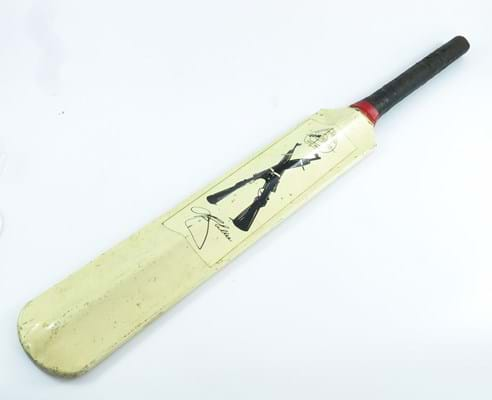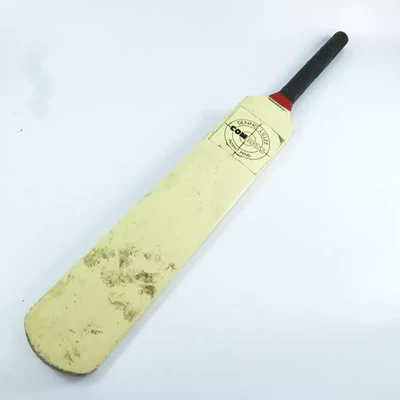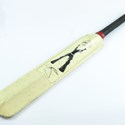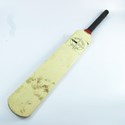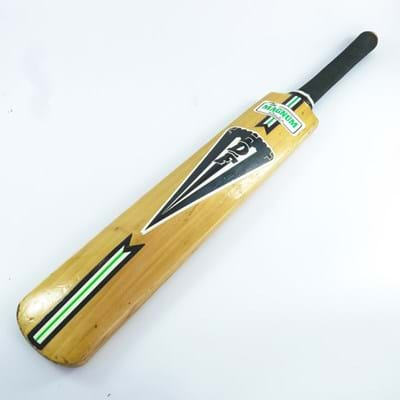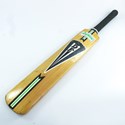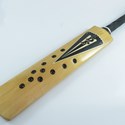The correct answer as an Englishman is of course ‘who cares, we won’, with apologies to the battling Kiwis, but cricket has long been a game with baffling technicalities and arguments. Take the first test of the 1979-80 Ashes series between Australia and England held at the WACA ground in Perth, December 1979.
When Ian Botham bowled at Dennis Lillee he was expecting the usual ball hitting willow response… only to hear a very strange sound described by a teammate as a ‘clang’.
Lillee was using a Combat – a bat made out of aluminium – and England kicked up an almighty stink about it, with the bat later banned.
Forty years later, a Worcestershire auction house has sold that very bat. The John Goodwin saleroom of Malvern offered what it dubbed “a unique piece of cricket history, probably the most notorious bat in cricket history” in its June 20 auction and it sold for a mid-estimate £5200 via a phone bid to a private buyer competing against a local cricket enthusiast.
Batty idea
Lillee had been persuaded by a friend that an aluminium bat, inspired by baseball, was a great idea. The Combat had previously been used in a game against the West Indies at Brisbane without incident but, on this occasion, it sparked complaints not just from the opposition but also the Aussie captain Greg Chappell.
After just four balls of the second day Lillee hit a straight drive down the ground which failed to reach the boundary. Chappell, convinced that the ball should have made the ropes, immediately asked 12th man, Rodney Hogg, to hand Lillee a traditional bat. This was bluntly refused by Lillee who continued to use the aluminium bat.
In the meantime, England captain Mike Brearley complained to the umpire that the Combat was damaging the ball. At this point Chappell lost his patience and walked onto the ground to present Lillee with a traditional willow bat. Lillee then hurled the aluminium cricket bat into the air. He added three more runs to his total before being caught.
Lillee later said he had checked with the authorities before Brisbane to see if the bat was allowed, and anyway: “That bat was not designed or made for first-class cricket. At half the price of a willow bat, we thought it would be useful for schools cricket, nets and for underdeveloped countries.
“People have asked me why I used it in a Test – it was a marketing ploy. I’m not ashamed of that. We wanted the bat to get some exposure for Christmas sales.”
Lillee saw the lighter side of it afterwards and said: “At the end of the game I got each side to sign the bat, and Mike Brearley wrote, Good luck with the sales. But we didn’t sell a single bat because they were banned.”
See background article on thecricketer.com for more.
Fearnley collection
The Combat was part of the Duncan Fearnley collection of cricket bats, several of which have been sold by John Goodwin. Fearnley, a cricketer who played for Worcestershire (and was later chairman), became a very successful manufacturer of bats. The company’s heyday was in the 1980s but it continues to make bats today on a smaller scale.
Also sold on June 20 was another banned bat example, previously used by Sunil Gavaskar. It was used by the Indian cricketer in the first test at Lord’s in 1979 but banned by the TCCB and MCC for causing damage to the ball. It had holes drilled to make it lighter.
At the John Goodwin sale it made a low-estimate £2000.
Another highly desirable bat from Fearnley’s collection was one specially handmade by him for Graeme Hick, used to score more than 1000 first-class runs before May 1986 and over 2000 that season. It is signed by Hick ‘another great piece of willow’. It made £3800 (estimate £1000-1500).
John Goodwin auctioneer Chris Maulkin said: “The successful bidder for most bats [on June 20] was an agent for a collector who was also successful in a previous sale and spends some of his time overseas. While on this occasion he was present in the room, in the UK to attend the World Cup, he had previously been successful on the telephone from India.”
Prices mentioned above are hammer prices. John Goodwin auction house charges a 15% buyer’s premium on top.


